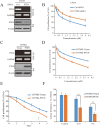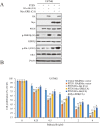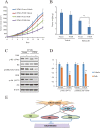Involvement of Phosphatase and Tensin Homolog in Cyclin-Dependent Kinase 4/6 Inhibitor-Induced Blockade of Glioblastoma
- PMID: 31787897
- PMCID: PMC6854038
- DOI: 10.3389/fphar.2019.01316
Involvement of Phosphatase and Tensin Homolog in Cyclin-Dependent Kinase 4/6 Inhibitor-Induced Blockade of Glioblastoma
Abstract
Dysregulation of retinoblastoma (Rb) signaling pathway have been established as a requirement for glioblastoma (GBM) initiation and progression, which suggests that blockade of CDK4/6-Rb signaling axis for GBM treatment. Palbociclib, a selective inhibitor of the cyclin-dependent kinases CDK4/6, has been applied for breast cancer treatment. However, its efficacy against glioblastoma has not been well clarified. Here, effects of CDK4/6 inhibitors on various kinds of GBM cell lines are investigated and the functional mechanisms are identified. Data showed that cells with diverse PTEN status respond to palbociclib differently. Gain-of-function and loss-of-function studies indicated that PTEN enhanced the sensitivity of GBM cells to palbociclib in vitro and in vivo, which was associated with suppressions of Akt and ERK signaling and independent of Rb signaling inhibition. Hence, our findings support that palbociclib selectively.
Keywords: CDK4/6 inhibitor; PTEN; glioblastoma; palbociclib; sensitivity.
Copyright © 2019 Liu, Yuan, Li, Qi, Guo, Yang, Zhou, Xu, Chen, Yang, Liu, Li, Yao and Jiang.
Figures






Similar articles
-
Inhibition of Rb and mTOR signaling associates with synergistic anticancer effect of palbociclib and erlotinib in glioblastoma cells.Invest New Drugs. 2018 Dec;36(6):961-969. doi: 10.1007/s10637-018-0575-z. Epub 2018 Mar 6. Invest New Drugs. 2018. PMID: 29508248
-
SPH3643: A novel cyclin-dependent kinase 4/6 inhibitor with good anticancer efficacy and strong blood-brain barrier permeability.Cancer Sci. 2020 May;111(5):1761-1773. doi: 10.1111/cas.14367. Epub 2020 Mar 24. Cancer Sci. 2020. PMID: 32103527 Free PMC article.
-
Inhibition of DNA damage repair by the CDK4/6 inhibitor palbociclib delays irradiated intracranial atypical teratoid rhabdoid tumor and glioblastoma xenograft regrowth.Neuro Oncol. 2016 Nov;18(11):1519-1528. doi: 10.1093/neuonc/now106. Epub 2016 Jul 1. Neuro Oncol. 2016. PMID: 27370397 Free PMC article.
-
Cyclin-dependent kinase 4/6 inhibitors in breast cancer: palbociclib, ribociclib, and abemaciclib.Breast Cancer Res Treat. 2017 Nov;166(1):41-54. doi: 10.1007/s10549-017-4385-3. Epub 2017 Jul 24. Breast Cancer Res Treat. 2017. PMID: 28741274 Review.
-
A combination of the PI3K pathway inhibitor plus cell cycle pathway inhibitor to combat endocrine resistance in hormone receptor-positive breast cancer: a genomic algorithm-based treatment approach.Am J Cancer Res. 2018 Dec 1;8(12):2359-2376. eCollection 2018. Am J Cancer Res. 2018. PMID: 30662797 Free PMC article. Review.
Cited by
-
Cyclin-dependent kinase inhibitors in head and neck cancer and glioblastoma-backbone or add-on in immune-oncology?Cancer Metastasis Rev. 2021 Mar;40(1):153-171. doi: 10.1007/s10555-020-09940-4. Epub 2020 Nov 8. Cancer Metastasis Rev. 2021. PMID: 33161487 Free PMC article. Review.
-
The Oncogenic Role of Cyclin-Dependent Kinase Inhibitor 2C in Lower-Grade Glioma.J Mol Neurosci. 2023 Jun;73(6):327-344. doi: 10.1007/s12031-023-02120-3. Epub 2023 May 24. J Mol Neurosci. 2023. PMID: 37223854
-
Apoptotic and DNA Damage Effect of 1,2,3,4,6-Penta-O-galloyl-beta-D-glucose in Cisplatin-Resistant Non-Small Lung Cancer Cells via Phosphorylation of H2AX, CHK2 and p53.Cells. 2022 Apr 14;11(8):1343. doi: 10.3390/cells11081343. Cells. 2022. PMID: 35456022 Free PMC article.
-
CDK4/6 inhibition to resensitize BRAF/EGFR inhibitor in patient-derived BRAF/PTEN-mutant colon cancer cells.Transl Cancer Res. 2024 Jul 31;13(7):3695-3703. doi: 10.21037/tcr-24-20. Epub 2024 Jul 12. Transl Cancer Res. 2024. PMID: 39145064 Free PMC article.
References
-
- Bollard J., Miguela V., Ruiz de Galarreta M., Venkatesh A., Bian C. B., Roberto M. P., et al. (2016). Palbociclib (PD-0332991), a selective CDK4/6 inhibitor, restricts tumour growth in preclinical models of hepatocellular carcinoma. Gut. 66, 1286–1296. 10.1136/gutjnl-2016-312268 - DOI - PMC - PubMed
LinkOut - more resources
Full Text Sources
Research Materials
Miscellaneous

